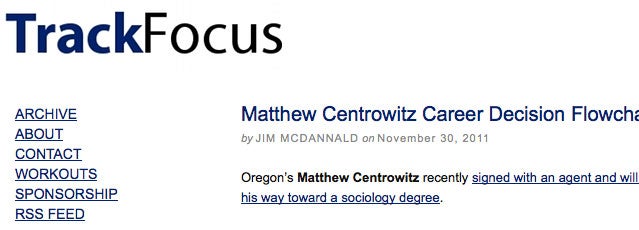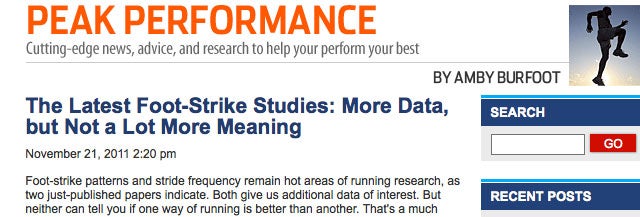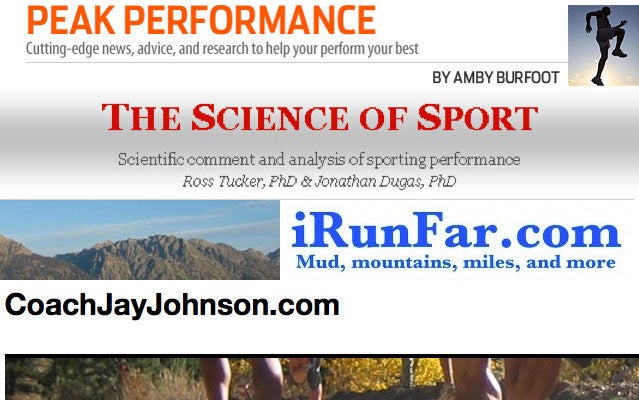The Top 10 Running Blogs
What is there to ? As it turns out, quite a bit—so much that easily half a dozen excellent blogs didn’t make this list. The aim here was to reach as many corners of the running blogosphere as possible, which meant leaving out plenty of athlete blogs, a , and more blogs than we can keep track of about the of . And that’s not even counting Alex Hutchinson’s blog or Pete Larson’s —certainly two of the finest running blogs around—which made our list of best fitness blogs instead. If you enjoy running anywhere as much as we do, these 10 blogs should keep your RSS feed humming well into the new year.
10. Running Technique Tips
9. Track Focus
8. Nate Jenkins’s Training Log
7. iRunFar
6. Coach Jay Johnson
5. Japan Running News
4. Runner’s World Daily
3. Track & Field Superfan
2. Peak Performance
1. Science of Sport
10. Running Technique Tips
The minimalist runner’s resource

Good for: Running-form advice and coaching tips.
Written by: Brian Martin, author and coach from Australia.
The title Brian Martin gave his blog——doesn’t quite do it justice. While form is a major topic, Martin also covers strength training, reviews shoes, and gives coaching advice. Last month, for example, he posted a detailed analysis of a top coach’s strength routine, wrote about foam rollers, and reviewed Nike’s Free 3.0.��
Sample post: Martin explains why regularly changing up your strength routine may yield better results.
Imagine turning up to training and having new exercises thrown at you day-in day-out, your body is going to be always on a steep and continuous learning curve that maximizes this potential for rapid neurological strength adaptations. Every time you get a new running related exercise you are improving your posture, stability, muscle activation patterns etc in slightly different ways. This all adds up to better running coordination and strength development over time – provided that the exercises are at least in some way identifiable with or related to running. …
9. Track Focus
Running news from Oregon (and beyond)

Good for: Quick hits on distance running news.
Written by: Doug Binder, former track writer for the Portland Oregonian, and Jim McDannald, coach at McGill University.
Blinder’s contacts from his years at the Oregonian make this blog a top choice for news out of Oregon. If that sounds a little narrow for your tastes, remember that three of the country’s leading pro training groups, one of the country’s top collegiate programs, and the world’s biggest shoe company are all based in Eugene or Portland. Binder and McDannald are often the first to hear of big news, and their commentary if usually right on the mark. (McDannald’s on miler Matt Centrowitz’s post-college options is pitch perfect.) The site provides aggregation with links to major stories, plus occasional original reporting focused on the sport’s major players.
Sample post: Binder that American record holder Alan Webb would miss the U.S. championships in June.
U.S. mile record-holder Alan Webb told me today in an email Monday that he is not going to run in Eugene next week.
Apparently, an injury setback interrupted his training.
Here is what he wrote:
“I will not be running at (U.S.) championships. I strained a muscle in my shin that I couldn’t seem to get right. It is much improved now but have had to take a little break.”
A potentially loaded 1,500 meters suddenly appears to have some wiggle room for a young up-and-comer. Could NCAA champion Matthew Centrowitz step into the mix for a U.S. team berth?…
8. Nate Jenkins’s Training Log
Go inside the head of an obsessive pro runner

Good for: Living the dream.
Written by: Nate Jenkins, 2:14 marathon runner.
Sure, most elite runners will tell you how they crushed their last long run, and they might even let slip a mention of their peak mileage. But hardly any open their training logs for public viewing.
That’s what makes so good. After placing 7th in 2:14 at the ‘08 Olympic Marathon trials, a back injury has prevented Jenkins from even qualifying for the ‘12 trials. But every workout he runs gets dutifully recorded, from the scary-good ones (four by two-miles averaging 4:45 mile pace in the middle of a 120-mile week) to the bad ones that leave him wondering whether to quit running and become a teacher.��
Jenkins also freely answers reader questions, and most weeks he posts detailed responses with training advice and general workout philosophies. In recent months, as Jenkins has recovered from back surgery, the blog has become as much a record of runs completed as a lesson in persistence.
Sample post: Jenkins summarizes a recent week and allows himself a moment of hope.
117 miles, two very solid workouts. I’m not sure if today’s tempo was a freak good day or a huge step in the right direction. I’m not making any decisions about another run at a qualifier yet, but a door I had considered closed last weekend I am now viewing as possibly open today. …
7. iRunFar
The ultrarunner’s resource

Good for: Everything ultrarunning.
Written by: Byron Powell, lawyer turned ultra fanatic.
is so good at what it does—shoe reviews, trail guides, race previews and reports, athlete interviews—that it’s tempting to call it a website and not a blog. Who else offers coverage this comprehensive of the ultrarunning scene and still manages to post gear reviews and the occasional trail guide? But since all of the site’s content is produced or edited by Powell or Andy Jones-Wilkins, we think it qualifies as a blog. That’s no slight, of course.
Sample post: Powell previews The North Face Endurance Challenge 50 Mile Championships.
…The guys at the bottom of the list, who’ll need a career day to go top 15 on Saturday, win local 50ks and routinely finish top three at established 100 mile races. This is of little surprise as for the past few years the only American ultra with a men’s field depth on par with the TNF 50 mile is Western States. Nothing else is close.
That said, it might be even harder to wrap one’s head around the talent at the front of this field. Here are the (American ultra) household names in the field: Roes, Wardian, Wolfe, Koerner, Jones, Bragg, Kaburaki, and Sharman. You might need to read that a few times for it to sink in. …
6. Jay Johnson’s Blog
Advice for coaches and runners alike

Good for: General strength and workout advice.
Written by: Jay Johnson, former University of Colorado assistant coach and core-strength expert.��
Johnson is best known for developing runner-specific core strength routines, but is thoughtful and covers every element of training and racing, with posts on hill running, the value of plyometrics, and the art of coaching young athletes. The best part? He regularly posts videos demonstrating how to perform core-strength exercises with proper technique.
Sample post: Johnson says high schoolers should do easy-to-master backwards lunges: They build strength and give young runners a sense of accomplishment.
Quick question. Should a runner be able to perform a forward lunge? If the answer is yes, then what about a backward lunge, which is more challenging?
If you don’t have a strong opinion either way, just try it. Either use a line or imagine a line and simply take some nice long lunges backwards on that line. You’ll probably be a little bit wobbly, but since the movement is similar to running – you’re still moving in the sagital plane, just as with running – you should be able to do it.
But many runners, especially young runners, can’t do it…or they can’t do it very well. Some are so wobbly that they have will need to reach down and touch the ground to keep from falling over, while others can only backwards lunge by taking shallow, short lunges, not the nice full, deep lunge that they’re able to do when moving forward.
5. Japan Running News
Updates on a famous running culture from across the pond

Good for: Racing news from Japan.
Written by: Brett Larner, a Canadian ex-pat living in Tokyo.
Japan has produced a surprising number of world-class marathoners. Why? A robust racing scene that revolves around ekidens, massive relays that pit runners from high schools, colleges, and professional teams against each other in races that sometimes take days to unfold and get exposure on national TV. (Imagine that in the United States!)
Ekidens provide some of the most exciting racing in the world, but they’re rarely covered abroad. Larner, who has lived in Tokyo since 1997, is immersed in the scene and posts English-language coverage of major marathons, plus athlete interviews and translations of news stories. Without , much of the Japanese running culture would be inaccessible to U.S. fans—and that culture could be the most exciting in the world.
Sample post: Larner breaks down the 2011 Hakone Ekiden, a two-day, 135-mile race between Tokyo and Hakone, Japan. Most DI cross-country teams would get their butts kicked.
They were the two best university teams ever assembled and they ran like it. After two-time defending champion Toyo University and 2010 National University Ekiden champion Waseda University both broke the Day One Hakone course record, Waseda hammered Toyo on the first two stages of Day Two to retake the lead and then held on to take the overall win in a course-record 10:59:50, the first school to ever break 11 hours on the celebrated 10-stage, 217.9 km course. Toyo nearly ran Waseda down on the final stage, finish 22 seconds back in the closest margin of victory in Hakone’s 87 year history and likewise breaking the course record by over 3 minutes. It was a classic duel between the elite Waseda, symbolic of the privilege, connections and money at the top of Japanese society, and the underdog Toyo, a minor school with a young coach with an eye for hidden talent and a group of guys who worked their way up together to become champions. …
4. Runner’s World Daily
A light take on all things running

Good for: “Running-related nonsense—some of it useful.”
Written by: RunnersWorld.com executive editor Mark Remy.
Ever met an over-serious runner? Remy has, and he’s been gently poking fun at the sport’s more absurd aspects for years. His blog is a collection of off-beat and occasionally heartwarming stories about running, with a good dose of self-deprecation. (In a recurring series, Remy of himself mid-race.)
Sample post: To his delight, a reader points Remy to a running escort service.
Today’s amazing-but-true news item comes to us via reader Janet Rosenthal, who stumbled across the following headline via something called ““:
Like a puppy handed a comically large rawhide bone, when I saw this headline I got so bouncy and excited I didn’t know where to start first.
So. First things first. The context:
This headline is from , which I gather is a saucy, sassy web site aimed at readers who lack a Y chromosome. It seems fun.
Second, the gist of the story. From the article: …
(Disclosure: Remy was my boss when I worked at Runner’s World.)
3. Track & Field Superfan
The blog for competitive-running nerds

Good for: Hard-core fans.
Written by: Jesse Squire, track fan.��
If you’re into competitive running, Jesse Squire’s is essential reading. You’ll find race recaps, news aggregation, and even mini essays on arcana like whether Toledo could host the NCAA cross country championships. His coverage of the sport is comprehensive, and his analysis is always well written and insightful.
Sample post: Every so often Squires puts together a gem of a post, , on how of amateurism rules in the NCAA could destroy minor sports like track:
Take a step back from the world of college sports and look at some ordinary middle class parents with ordinary middle class kids who are looking at the extraordinary costs of a college education, which has doubled every nine years of the last few decades while middle-class income has stayed flat. Many of them look at high school athletes who have signed for a college scholarship as if they had won they lottery.
Sportswriters, of course, spend more time talking to coaches than the academics that make the whole place function. They only cover the star athletes on profit-making football and basketball teams instead the rank-and-file swimmers, runners and soccer players. Their world is the athletes that are underpaid. As track fans, our world is those who are overpaid. Any track person who even gets meal money on a road trip is a net drain on the athletic department and is overpaid. Period. Track does not make more than it spends…
2. Peak Performance
A former Boston Marathon champ reads and digests the newest research on the science of exercise

Good for: Analysis of the newest research in exercise physiology.
Written by: Amby Burfoot, Runner’s World Editor at Large and 1968 Boston Marathon champion.
Burfoot brings decades of experience as a runner and journalist to his . He combs through the newest research on exercise and performance, putting together detailed but highly readable posts on fueling for marathons, running form, and the health benefits of exercise. Posts range from quirky (““) to serious (““) Over the years, Burfoot has interviewed just about every exercise physiologist of note. That gives the blog some real intellectual heft, without ever feeling hefty.
Sample Post: Burfoot connects a study of an ultrarunner named Philippe Fuchs with questions about stride rate and the world’s best sprinter, Usain Bolt.
First, how is Bolt like an ultrarunner? Easy. Neither cares much about running economy. Bolt consumes oxygen like a fireball. He doesn’t even have to breathe during a 100. If he goes deep into oxygen debt, it’s no big problem, because he’s going to stop in a second or two.
Strangely enough, running economy doesn’t matter to ultrarunners either… Why not? Because running economy isn’t crucial to an ultrarunner. You don’t require a super cardiovascular system to pad along at 10 to 12 minutes per mile. You need a body that just won’t break down. You need to improve your mechanical efficiency, but not necessarily your oxygen efficiency. …
1. Science of Sport
In-depth analysis of the sport’s biggest issues

Good for: A scientific perspective on major races, doping, and the value of running shoes.
Written by: Jonathan Dugas and Ross Tucker, exercise physiologists from South Africa.��
Running is only one of the sports under consideration on this blog—Dugas and Tucker also write about rugby, soccer, and cycling—yet somehow the pair give a scientific treatment to all of running’s most compelling topics, often in real time. Wondering about going barefoot? There are no fewer than five comprehensive posts. Likewise for doping, Oscar Pistorius, over hydration, and the growing talent vs. practice debate. Though sometimes lengthy, the posts are carefully considered and easy to digest.
Sample post: Tucker does a on the state of science of barefoot running.
There is as yet no conclusive evidence that either proves or disproves the benefits of shoes or barefoot running, or links the mechanical characteristics of barefoot running to a reduced risk of injury. That is, for all the work showing how impact forces and loading rates are reduced when barefoot, it remains to be proven that this leads to lower injury rates. ��I began last night’s talk by saying that this was the first time a “scientific” presentation would be given with so little conclusive scientific evidence! ��There are plenty of theories, of course, and some are sound, but we await the real evidence for the injury and performance side of the debate, which will come from long-term, prospective studies….
The key point is that barefoot running (and thus running in general) should be recognized as a SKILL, and it is clear that we do not all have the ability to acquire skills equally. …��


